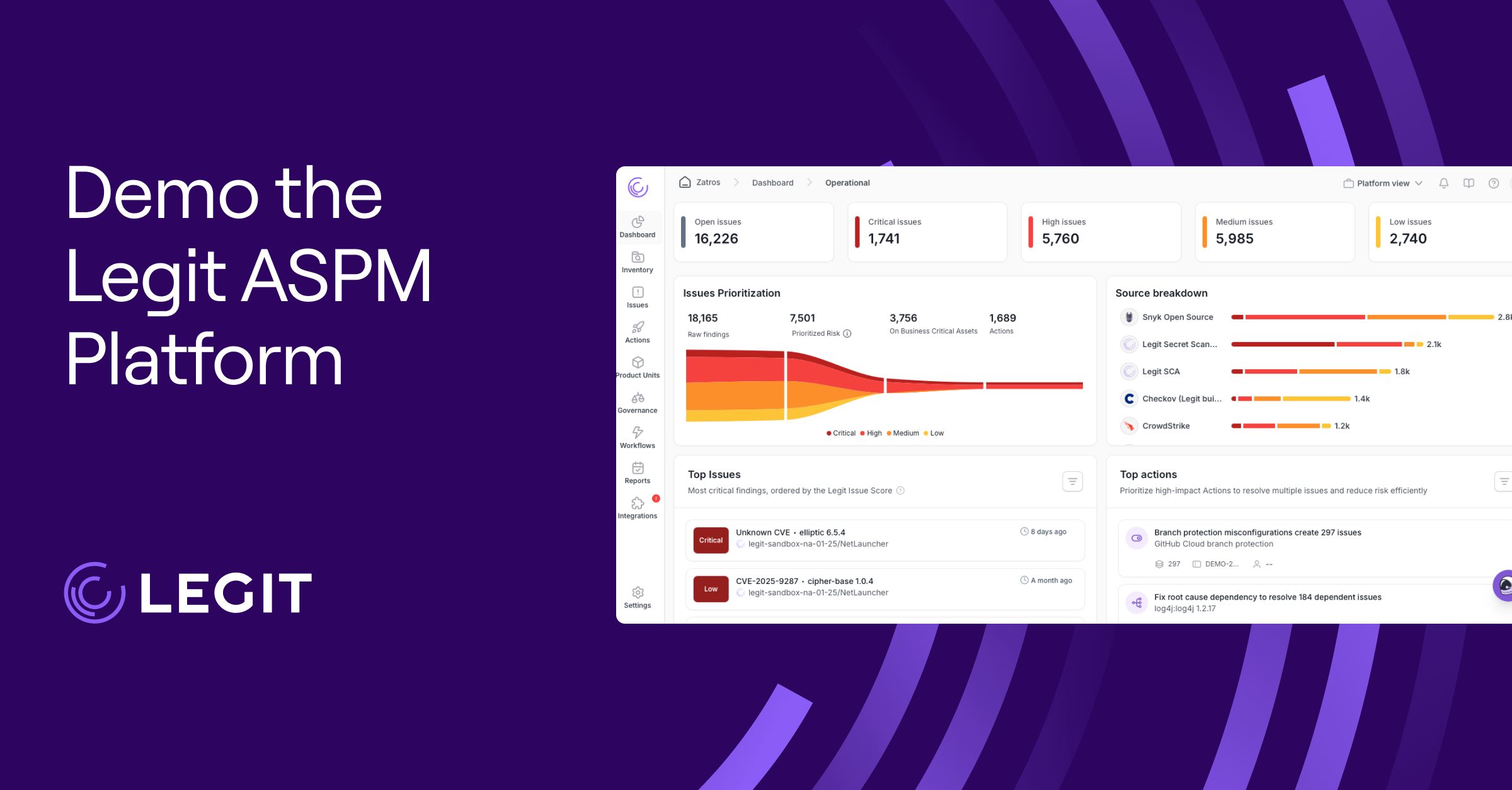Security vulnerabilities pop up constantly. Misconfigurations, unpatched software, and weaknesses in third-party components are difficult to avoid. Without a structured way to detect and fix them, these gaps become prime targets for attackers. That’s where the vulnerability management lifecycle comes in.
Vulnerability management works to find, prioritize, and fix gaps before exploitation. Each stage in the cycle secures software environments by reducing attack surfaces and maintaining security.
This article breaks down each lifecycle stage, explores common security challenges, and highlights the importance of the vulnerability management lifecycle. Here’s a clear roadmap for reducing security risk and strengthening your organization’s defenses.
What Is the Vulnerability Management Lifecycle?
Security isn’t a one-and-done effort. With the potential for thousands of new vulnerabilities to emerge each month, security teams need a proactive, risk-driven approach to continuously minimize exposure and maintain compliance with industry standards.
The vulnerability management lifecycle is a structured, continuous process designed to identify, assess, and remediate security weaknesses. The goal is to fix gaps across applications, servers, cloud environments, and network infrastructure before attackers can exploit them.
This lifecycle has six phases: discovery, prioritization, assessment, reporting, remediation, and verification. Integrating threat lifecycle management with secure software development lifecycle (SDLC) practices also streamlines remediation and reduces long-term risk.
The Importance of Vulnerability Management Lifecycle
By managing vulnerabilities effectively, you actively reduce risk, protect business continuity, and ensure compliance. Here’s why the security lifecycle is essential for your organization:
- Reduces security risks: Identifying and fixing vulnerabilities before they’re exploited strengthens your security posture, reducing the risk of breaches.
- Offers better visibility into threats: A structured vulnerability assessment process helps you understand security gaps across all applications and networks, so you can focus on the most significant risks.
- Helps you meet compliance requirements: Many frameworks, including the International Organization for Standardization (ISO) 27001, the National Institute of Standards and Technology (NIST) Cybersecurity Framework, and the Payment Card Industry Data Security Standard (PCI DSS), require a structured vulnerability management process. Compliance avoids penalties and strengthens customer trust.
- Prevents downtime and costly disruptions: Security incidents halt operations. A well-managed vulnerability lifecycle addresses weaknesses early to help businesses run smoothly.
- Strengthens security in the development process: Catching vulnerabilities before they reach production reduces security debt and teams ship safer applications.
- Highlights the right issues: Not every vulnerability needs immediate attention. A strong vulnerability lifecycle strategy helps teams prioritize based on vulnerability scoring and business impact.
- Allows for proactive defense: Continuous monitoring and automation help teams detect vulnerabilities in real time, act before attackers do, and identify emerging attack patterns.
- Builds long-term resilience: By following vulnerability management best practices and refining approaches over time, teams improve security effectiveness and adapt to evolving threats.
The 6 Vulnerability Management Lifecycle Phases
The steps in the vulnerability management lifecycle include six structured phases:
1. Discovery
Before securing an environment, you need to know what to protect. The discovery phase focuses on creating an extensive asset inventory, including all applications, endpoints, cloud resources, and third-party dependencies.
Without a proper inventory, you risk leaving vulnerabilities unmonitored, giving attackers potential entry points into networks. Identify which assets are business-critical, uncover unauthorized or hidden systems (shadow IT), and establish clear security objectives.
2. Prioritization
Not every vulnerability carries the same level of risk, so prioritize the most pressing threats first. Evaluate vulnerabilities based on severity, exploitability, and criticality to business operations. For example, vulnerabilities affecting assets that handle sensitive data or are exposed to external threat actors should take priority over those in isolated test environments.
Compliance requirements, such as PCI DSS and NIST standards, also play a role in determining which vulnerabilities demand immediate attention. Leveraging common vulnerabilities and exposures (CVE) data helps you quickly identify known threats and their associated risks.
3. Assessment
After prioritizing assets, it's time to assess them for security weaknesses. Conduct regular vulnerability scans to detect security weaknesses across infrastructure. These scans, along with penetration testing and application risk assessments, identify misconfigurations, outdated software, and potential entry points that threat actors could exploit.
While automated tools identify known vulnerabilities, manual testing methods like penetration testing offer a deeper understanding of business-critical risks and how sophisticated threat actors might attempt to breach your systems.
4. Reporting
After completing the assessment, translate raw vulnerability data into a clear, actionable report. The reporting phase provides a detailed overview of discovered vulnerabilities, including risk analysis, prioritization, and root cause analysis.
Instead of simply listing technical findings, reports should connect vulnerabilities to potential business impacts, helping decision-makers understand the urgency of remediation efforts. Effective reporting also enhances compliance with industry regulations and informs stakeholders of the organization's security posture.
5. Remediation
The next step is taking action. Depending on the severity, you might apply patches, update system configurations, or implement compensating controls to mitigate risk. If an immediate fix isn’t available, segmentation and access restrictions can help minimize exposure.
6. Verification
After applying fixes, reassess affected systems to confirm security. This may involve using a vulnerability scanner, performing additional security testing, or monitoring for any unintended side effects of remediation. Continuous reassessment enhances efficiency and strengthens long-term security posture.
Common Vulnerability Management Lifecycle Challenges
Identifying and remediating security weaknesses is only part of the equation. You must also apply fixes efficiently while maintaining business operations without disruption—and that’s a challenge.
Here are some of the biggest obstacles security teams face:
Inefficiency
Without automation and a structured workflow, the vulnerability management process can quickly become inefficient. If security tools rely on manual tracking or don’t easily integrate, your team could end up sifting through duplicate findings, chasing down remediation efforts, and struggling to manage high volumes of vulnerability data. This risks wasting time on low-priority vulnerabilities while critical threats remain unresolved.
Time Constraints
New vulnerabilities appear daily. Security teams must identify, assess, prioritize, remediate, and verify vulnerabilities across the organization—all while keeping systems running smoothly.
A recent analysis of CISA’s Known Exploited Vulnerabilities (KEV) catalog found that critical vulnerabilities take a median of 137 days to patch. That’s over four months where attackers have an open window to exploit known weaknesses. Finding the balance between quick remediation and business continuity is a challenge that requires careful planning.
Few Resources
Even with automation, vulnerability management requires skilled security professionals, advanced scanning tools, and continuous monitoring. If the team is small or overstretched, vulnerabilities pile up quickly, leaving gaps in security coverage.
Some organizations turn to managed security service providers (MSSPs) for extra support, but outsourcing doesn’t always guarantee timely remediation. If your security strategy relies too heavily on external vendors, critical vulnerabilities may linger longer than necessary.
New Threats
Fixing vulnerabilities today doesn’t mean your environment is secure tomorrow. Attackers move fast, and without real-time threat intelligence, you risk prioritizing outdated vulnerabilities while missing emerging attack vectors. Regular scans with an updated vulnerability scanner identify new threats before they can be exploited.
Compliance
Security standards like ISO 27001 enforce security best practices, but they also introduce challenges. Security teams may spend more time generating compliance reports than addressing risks.
When audits demand strict remediation timelines and excessive documentation, teams must prioritize regulatory checkboxes over real-world security threats. This could lead to misaligned priorities and wasted resources.
Other Solutions
Patches don’t guarantee security. Some patches introduce new vulnerabilities, requiring additional testing and configuration adjustments. Without automated validation tools, it’s easy to overlook weaknesses attackers can exploit.
Identify Vulnerabilities With Legit Security
A strong vulnerability management lifecycle helps you avoid threats, but manual processes slow teams down and leave security gaps. Employ continuous monitoring and automation to identify vulnerabilities early and streamline remediation to reduce risk.
The Legit ASPM Platform acts as the foundation of your application security program, ensuring all your AppSec testing is more effective and efficient. Legit discovers and visualizes all aspects of both applications and the software factory producing these assets, plus all security controls and gaps. Further, it consolidates security findings across all your scanners and tools (i.e., SCA, SAST, DAST, etc.), leveraging AI-driven correlation and risk scoring to fix your most critical issues, first.
Download our new whitepaper.


